Modern wood flooring has evolved far beyond simple planks, offering homeowners countless ways to transform their spaces into stunning showcases of craftsmanship and style. From timeless parquet patterns that recall European elegance to contemporary wide-plank installations that embrace minimalist aesthetics, today's wood floor designs blend traditional techniques with innovative approaches. Whether you're planning a complete renovation or updating existing flooring, these diverse design ideas showcase how wood floors can become the defining feature of any interior, combining natural beauty with functional durability to create spaces that feel both sophisticated and welcoming.
1. Light Wood Floor Scandinavian Style
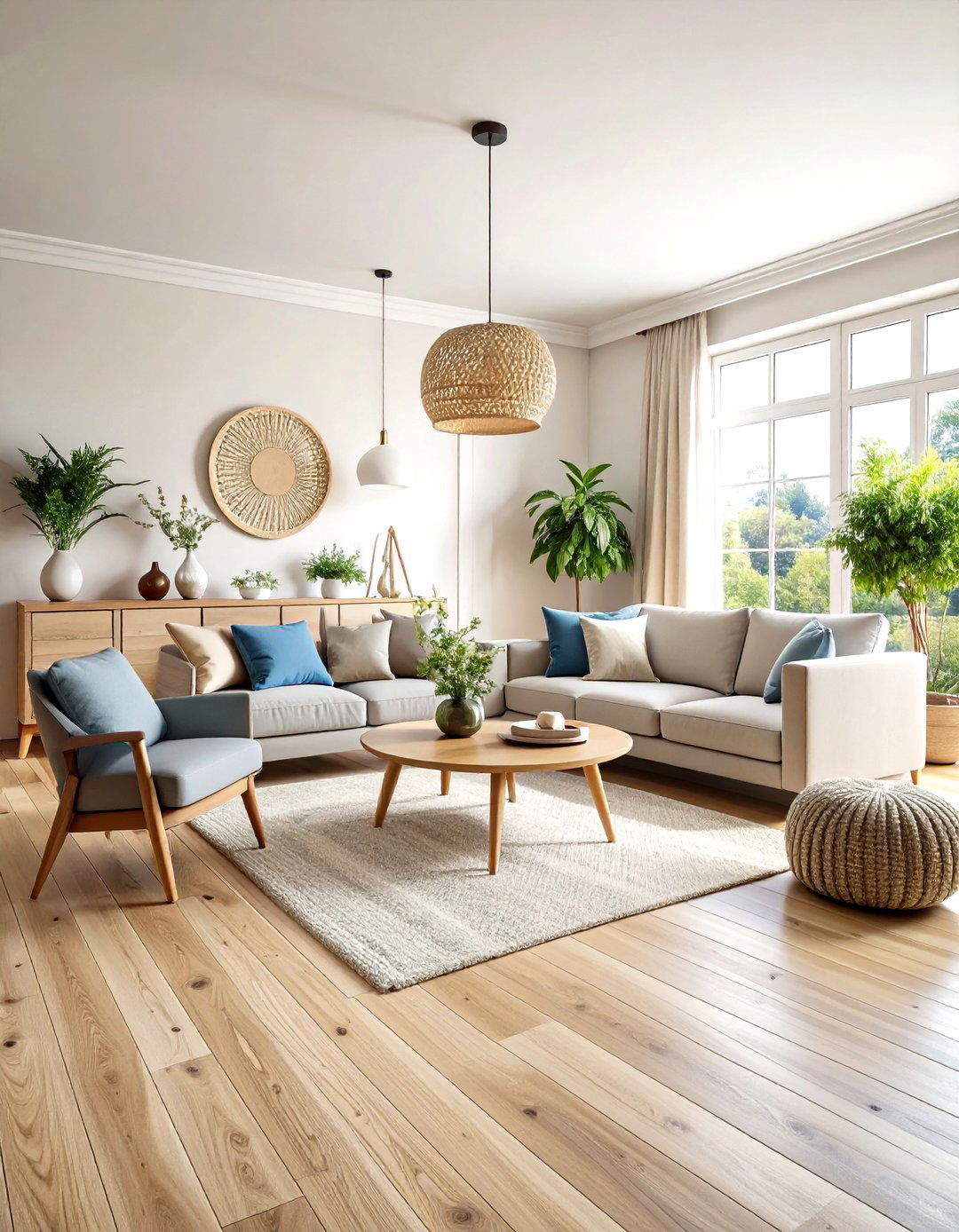
Light wood floors embody the essence of Scandinavian design, creating bright, airy spaces that maximize natural light and promote tranquility. These pale, natural tones from blonde oak to gentle ash reflect sunlight beautifully, making rooms appear larger and more open than they actually are. The trend draws clear inspiration from Scandinavian interiors, where maximizing natural light is essential to design, and works particularly well in modern and minimalist homes. The subtle grain patterns in light wood create visual interest without overwhelming the space, while their versatility allows them to complement both cool and warm color palettes. This timeless choice provides an excellent foundation for various decorating styles while maintaining a fresh, contemporary feel.
2. Wide Plank Wood Floor Installation
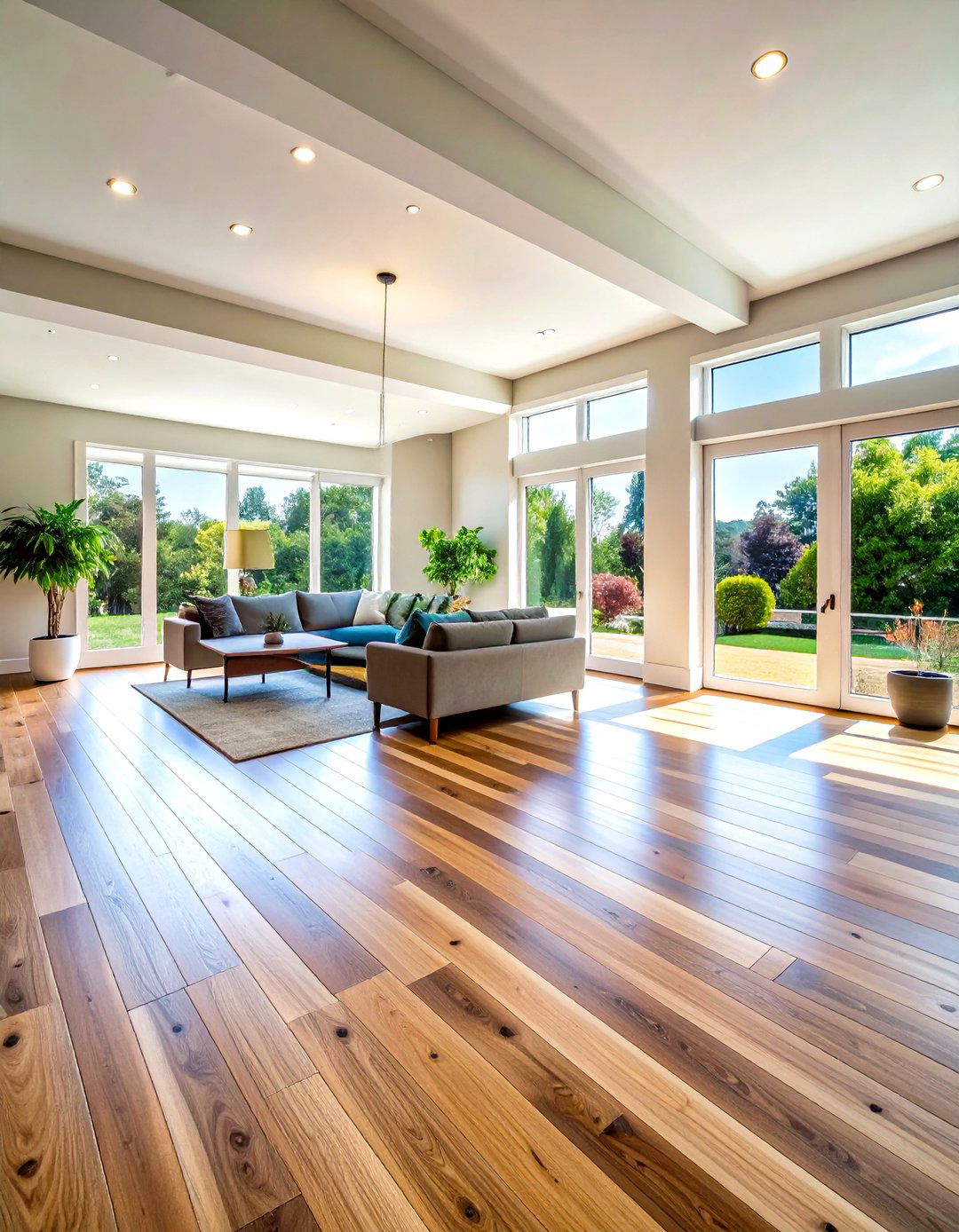
Wide plank wood floors measuring 7 inches or more create a luxurious, high-end appearance that's becoming increasingly popular in modern homes. Today's most popular planks run between 8 to 12 inches wide, a dramatic shift from the traditional 2.25 to 4-inch boards we've seen for decades. These broader planks showcase more of the wood's natural grain and character, creating visual continuity across large spaces and reducing the number of seams for a cleaner aesthetic. Wide planks work exceptionally well in open-concept homes where they enhance the sense of spaciousness and flow. Whether finished with rustic hand-scraped textures or smooth contemporary surfaces, wide planks provide versatility that suits both traditional and modern interior styles while creating an unmistakably upscale foundation.
3. Herringbone Wood Floor Pattern

Herringbone wood floors feature rectangular planks arranged in a distinctive zigzag pattern where the end of one plank meets the side of another at 90-degree angles. Herringbone floors have a rich history as a traditional floor pattern in Europe, and this classic design continues to captivate homeowners seeking timeless elegance. The pattern creates natural movement and rhythm across the floor surface, making spaces feel more dynamic and visually interesting. Herringbone works particularly well in narrow hallways and transitional spaces where it can guide the eye and create the illusion of greater width. Modern installations often use wider planks than traditional versions, creating a more contemporary interpretation while maintaining the pattern's historical charm and sophistication.
4. Chevron Wood Floor Design
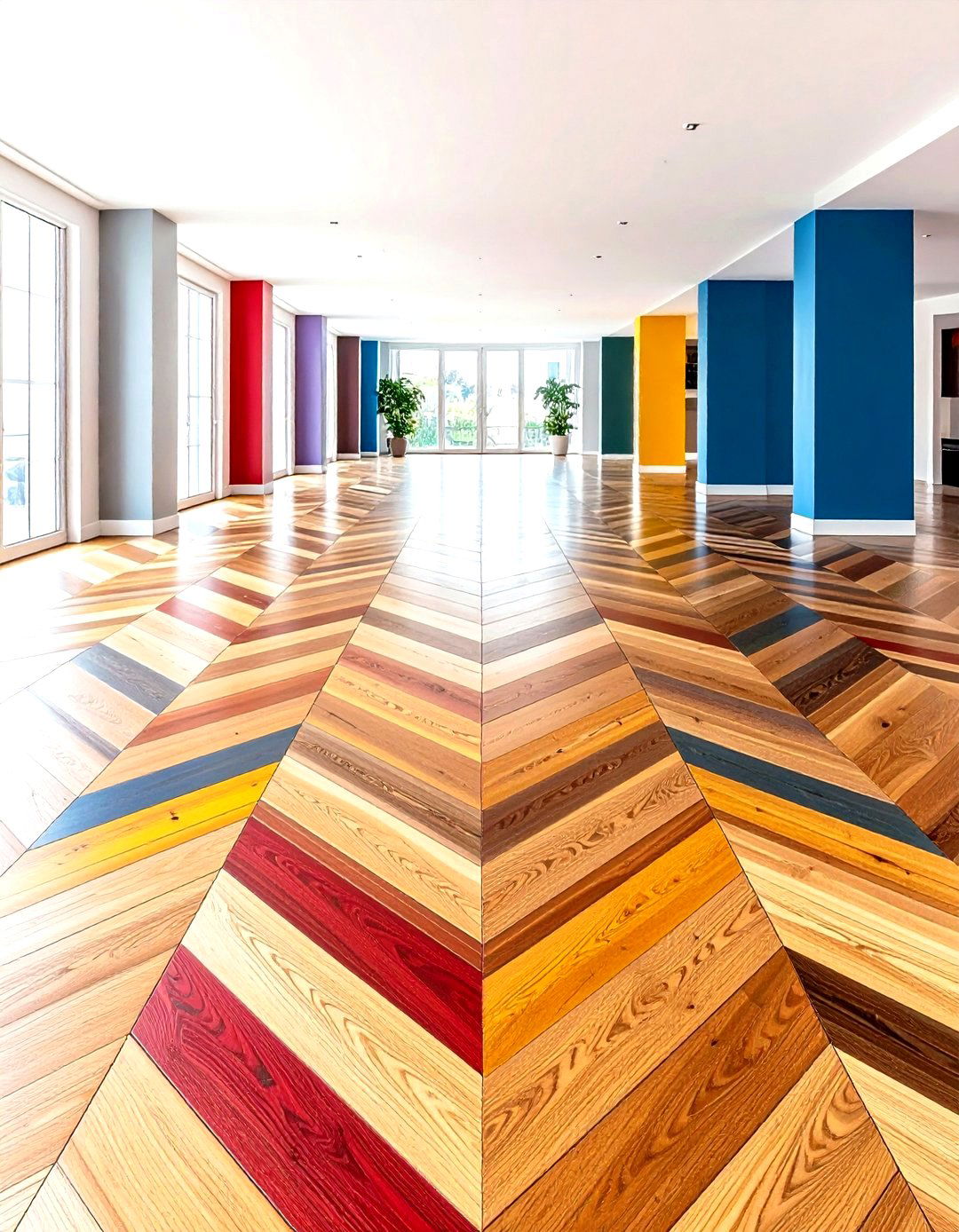
Chevron wood floors create bold, geometric beauty through planks cut at precise 45-degree angles that meet to form continuous V-shaped arrows. Because of the angular cut, the chevron pattern often results in a higher priced flooring, but the dramatic visual impact justifies the investment for many homeowners. Unlike herringbone's staggered appearance, chevron offers perfect symmetry and clean lines that feel distinctly contemporary. This pattern naturally guides the eye through a space and can make rooms appear longer or wider depending on the installation direction. Chevron works exceptionally well in modern farmhouse designs and contemporary interiors where its bold geometry serves as a striking architectural element that commands attention while maintaining sophisticated elegance.
5. Dark Stained Wood Floor Elegance
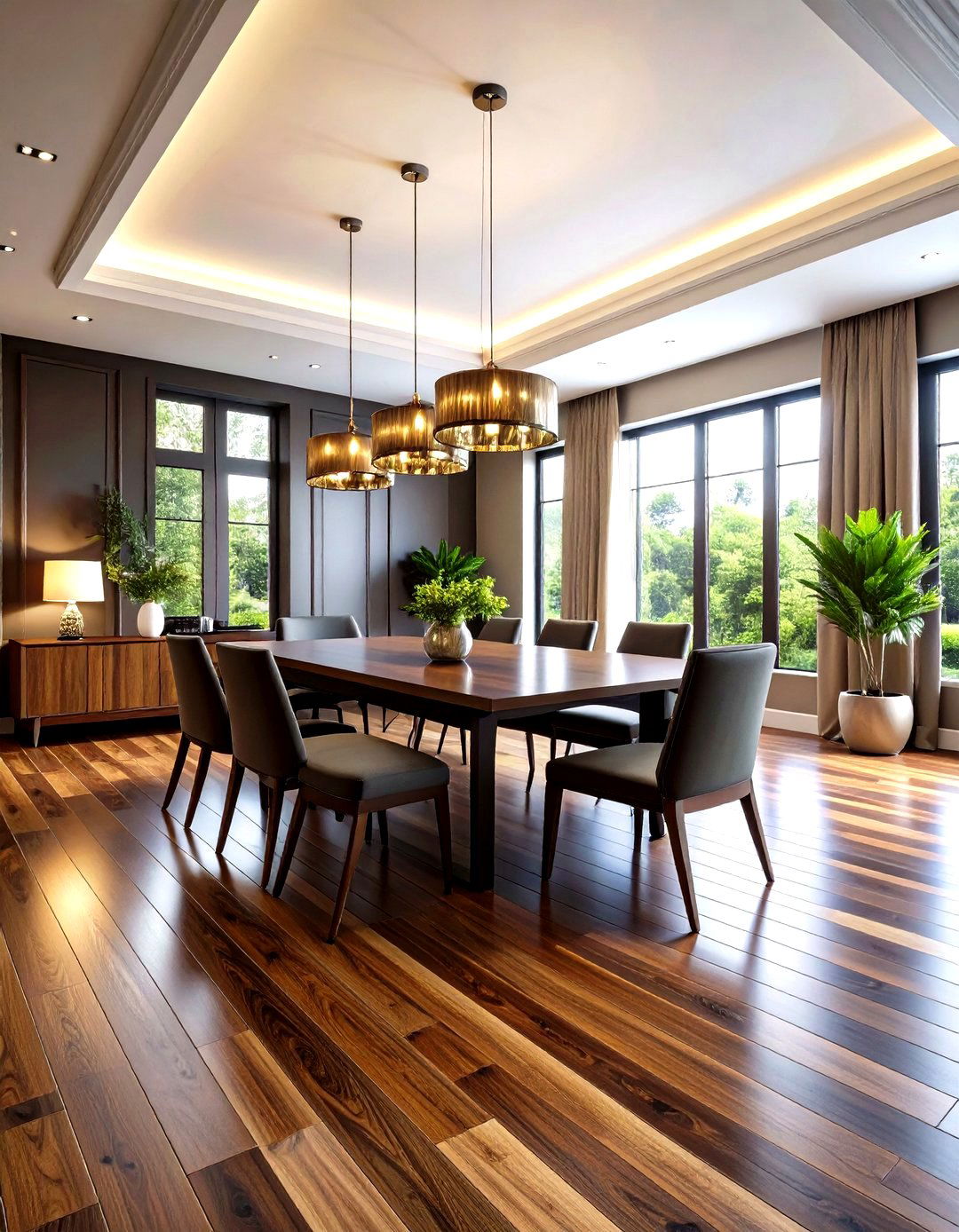
Dark stained wood floors in rich espresso, ebony, and charcoal tones create dramatic sophistication that anchors any interior design scheme. These finishes may include high-gloss options that create a polished and upscale look, making spaces feel more formal and luxurious. Dark stains work particularly well with lighter wall colors and furnishings, creating striking contrast that highlights both elements. These floors hide certain types of wear while showing dust more readily, making them ideal for formal living areas and dining rooms. The depth and richness of dark stained floors complement traditional furniture beautifully while also providing dramatic contrast in contemporary spaces, making them a versatile choice for homeowners seeking bold, statement-making flooring.
6. Mixed Width Wood Floor Planks

Mixed width wood floor installations combine planks of varying widths within the same floor, creating visual movement and custom character that breaks away from uniform traditional patterns. This allows for creative expression and a custom look that reflects personal taste, while providing both contemporary appeal and rustic charm. The varying widths create natural rhythm and flow across the floor surface, making spaces feel more organic and less formal than single-width installations. This approach works particularly well in transitional homes where homeowners want character without committing to one specific style. Mixed width installations can also be more environmentally conscious, as they allow for more efficient use of wood materials and potentially reduce waste from the milling process.
7. Hand-Scraped Wood Floor Texture

Hand-scraped wood floors replicate the authentic look of antique hardwood worn smooth over generations, featuring carefully crafted waves, dips, and texture that create warmth and character. Modern hand-scraping aims for authentic, natural-looking wear, moving away from heavy distressing toward subtle texturing that adds depth without appearing artificial. These textured surfaces excel at hiding daily wear and tear, making them practical for busy households with children and pets. The natural-looking variations bring warmth and authenticity that's impossible to achieve with perfectly smooth boards. Hand-scraped finishes work beautifully in farmhouse-inspired interiors and traditional settings while adding organic character to contemporary spaces seeking a softer, more lived-in aesthetic.
8. Gray-Washed Wood Floor Finish

Gray-washed wood floors offer contemporary sophistication through subtle silver tones that bridge the gap between traditional wood and modern design preferences. The gray tones hide everyday dirt and common wear better than natural wood, but they won't show scratches as much as solid gray stains do. This versatile finish works beautifully with both cool and warm color schemes, making it an excellent choice for homeowners who frequently change their décor. The weathered appearance creates a coastal or industrial aesthetic while maintaining the warmth and natural beauty of wood. Gray-washed floors complement earth-tone interiors perfectly and provide an excellent foundation for contemporary furniture and modern architectural elements.
9. Natural Oak Wood Floor Beauty
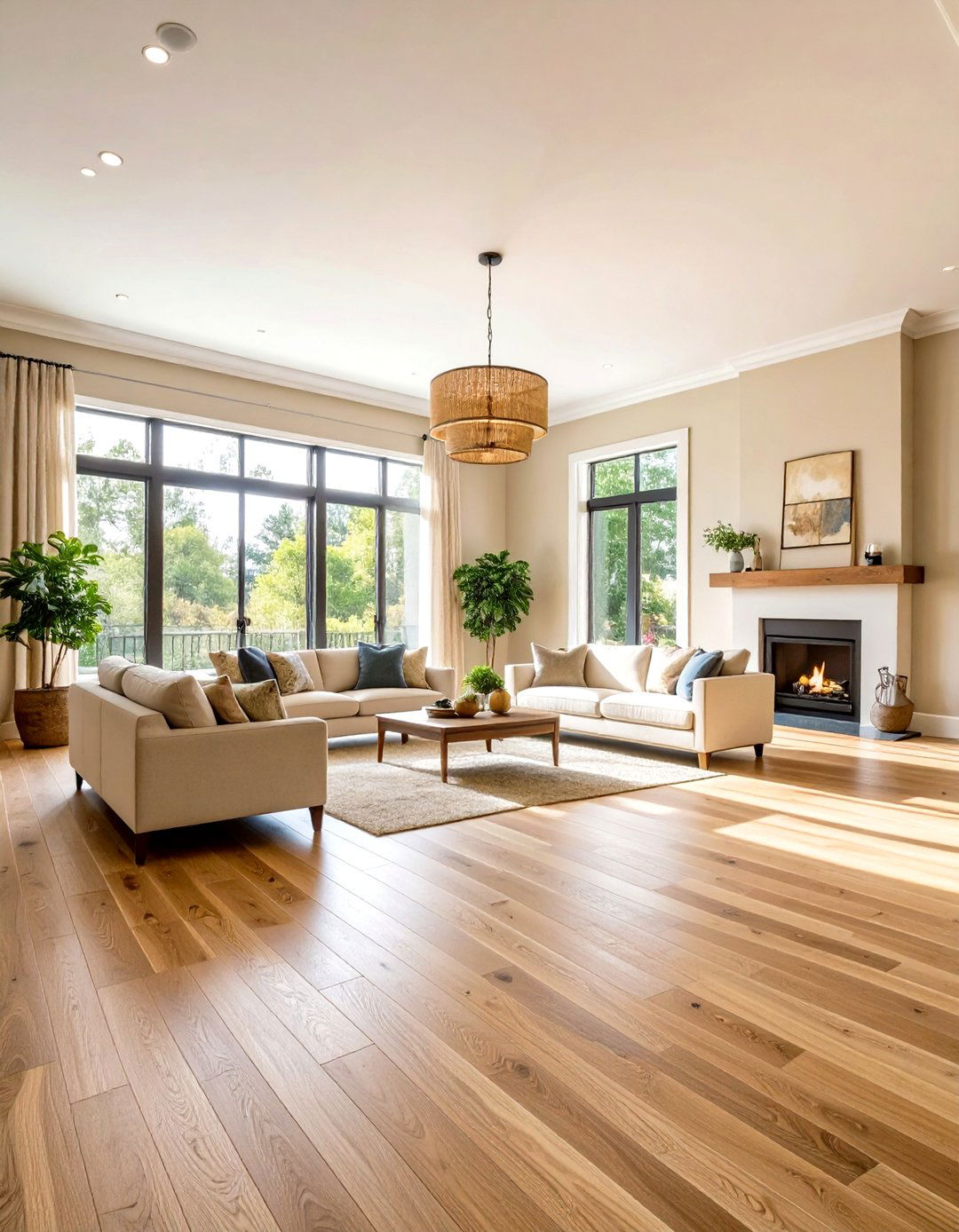
Natural oak wood floors celebrate the inherent beauty of one of America's most beloved hardwood species, showcasing the wood's distinctive grain patterns and warm, honey-colored tones. Natural Oak celebrates the wood's inherent beauty with its pale, neutral tone, bringing out the grain patterns and adding texture and visual interest. Oak's open grain structure accepts stains beautifully when color is desired, but natural finishes highlight the wood's authentic character. This classic choice works seamlessly in both traditional and contemporary settings, providing warmth without overwhelming other design elements. Natural oak floors age gracefully, developing a rich patina over time that adds to their character and appeal, making them an excellent long-term investment for any home.
10. Parquet Wood Floor Patterns
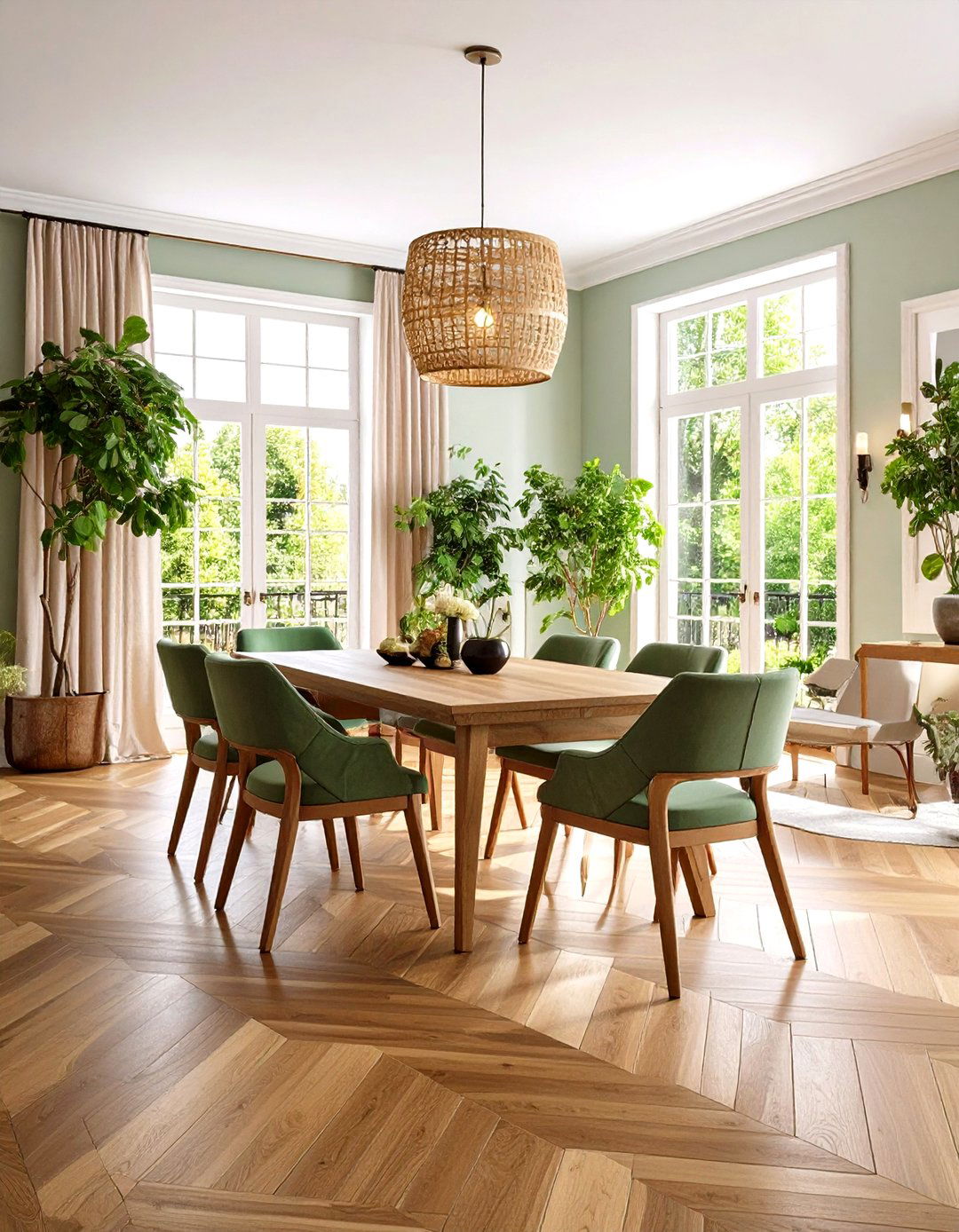
Parquet wood floors feature intricate geometric designs created by arranging small wood pieces in various patterns, from traditional herringbone and basket weave to contemporary artistic layouts. Originally introduced in 16th-century France, parquet has evolved into a sophisticated hardwood flooring style that suits both traditional and contemporary interiors. These patterns add instant artistry and individuality to any space, creating focal points that serve as conversation pieces. Parquet works exceptionally well in formal areas like dining rooms and foyers where elegant detail is appreciated. Modern parquet installations often use larger-scale patterns and contemporary wood finishes, updating this historical technique for today's design preferences while maintaining its sophisticated European heritage.
11. Wire-Brushed Wood Floor Texture
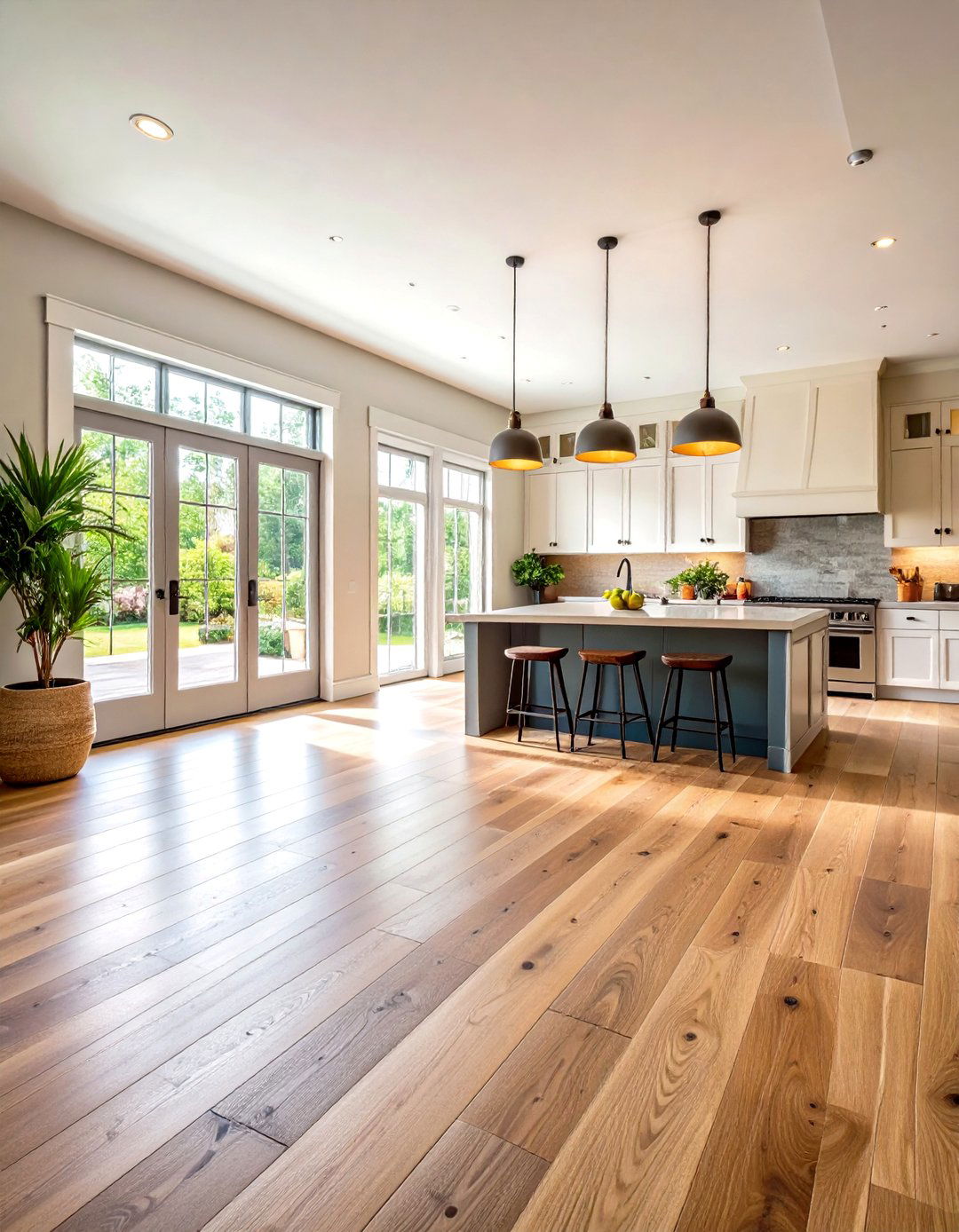
Wire-brushed wood floors feature subtle grooves and ridges created through specialized brushing techniques that expose the wood's natural grain structure and create authentic rustic appeal. This technique adds subtle grooves and ridges to your hardwood floors, providing a rustic and authentic appearance. It also helps to mask wear and tear over time. The wire-brushing process brings the heartwood to the surface, creating tactile interest that invites touch while adding visual depth. This textured finish works particularly well with oak and hickory species, where the natural grain patterns become more pronounced. Wire-brushed floors should typically receive matte finishes to maintain their natural, rustic appearance while providing the durability needed for high-traffic areas.
12. Warm Honey Oak Wood Floor Tones

Warm honey oak wood floors bring golden, sun-kissed hues that create inviting, cozy atmospheres while showcasing oak's distinctive grain patterns. Honey oak and walnut are making a comeback. "Strong, confident, warm browns will be trending throughout 2025," says Skutelsky. These warm tones pair beautifully with soft furnishings and muted colors, creating spaces that feel embracing and comfortable. Honey oak works exceptionally well in family rooms and kitchens where warmth and hospitality are priorities. The golden undertones complement both traditional and contemporary décor while providing enough character to stand alone as a design element. This classic finish ages beautifully, developing deeper richness over time while maintaining its welcoming, homey appeal.
13. Reclaimed Wood Floor Character
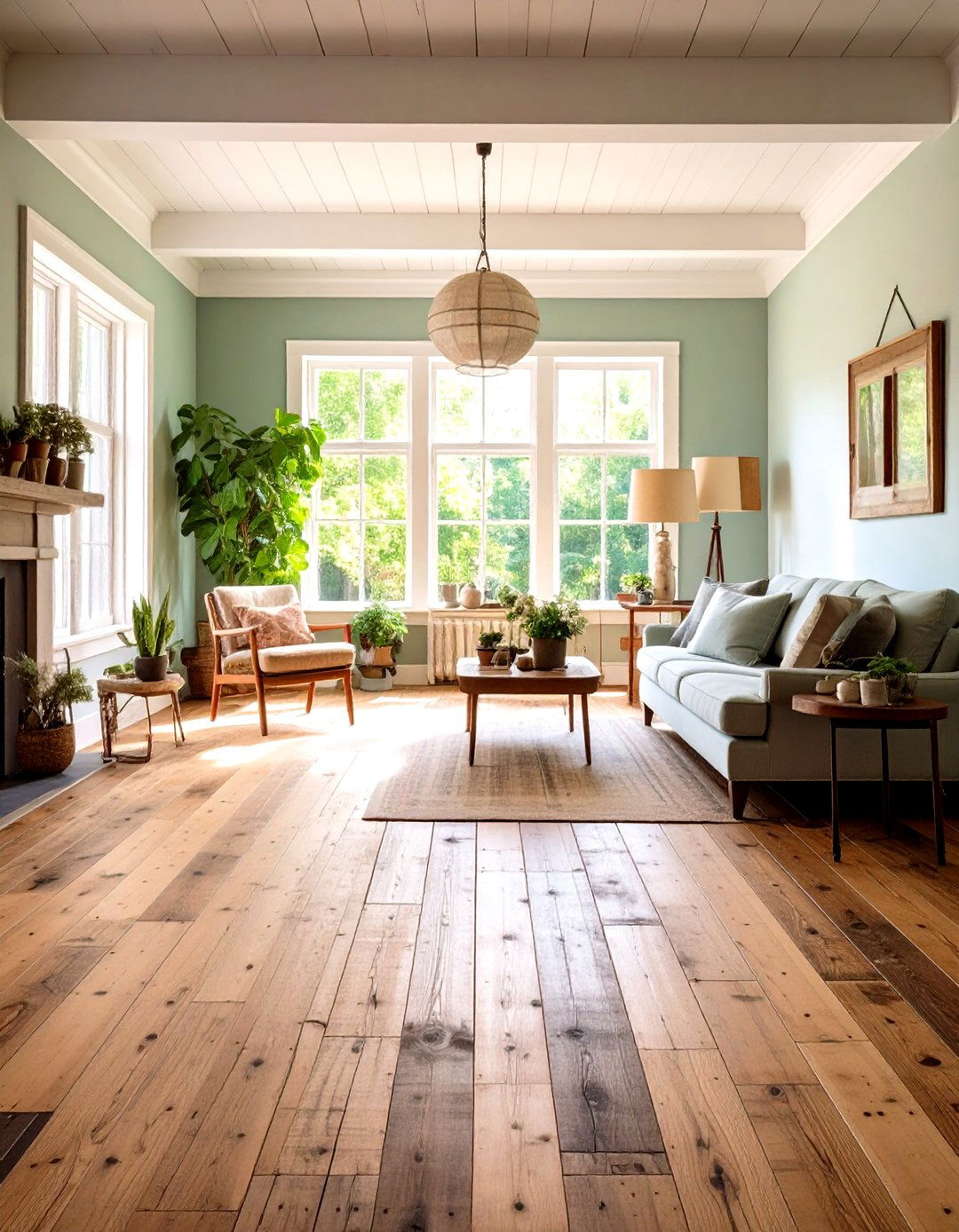
Reclaimed wood floors showcase sustainability and character through planks salvaged from old buildings, barns, and structures, each carrying unique history and patina that new materials cannot replicate. Reclaimed wood flooring is at the forefront of this trend, as it not only showcases the beauty of natural wood but also embodies a commitment to sustainability. These floors feature natural wear patterns, nail holes, and weathering that create instant character and authenticity. The varied grain patterns and natural imperfections tell stories while providing environmental benefits through material reuse. Reclaimed floors work particularly well in farmhouse, industrial, and rustic contemporary settings where their history and character become integral parts of the design narrative.
14. Mixed Material Wood Floor Designs
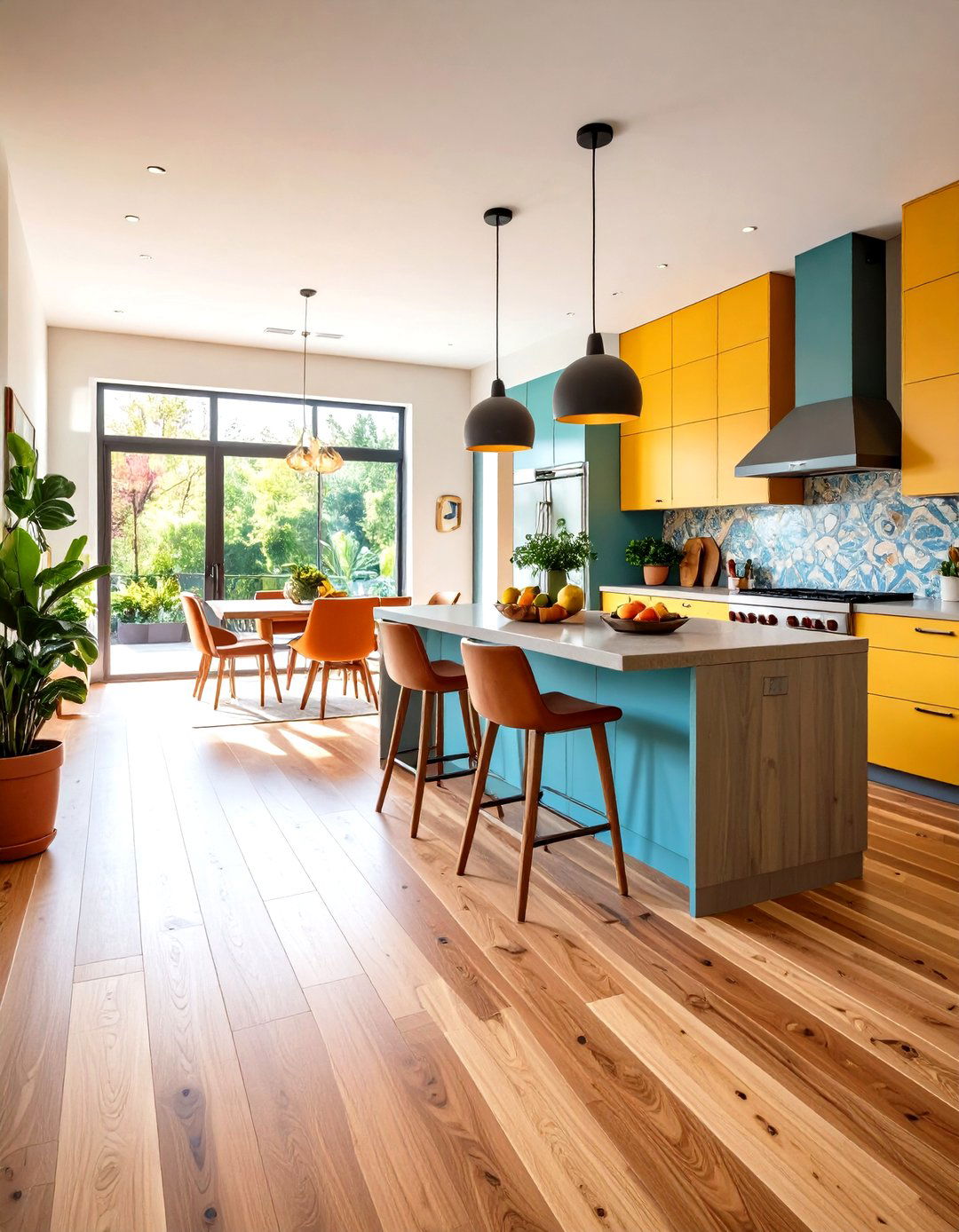
Mixed material wood floors combine traditional hardwood with stone, tile, or metal elements to create striking, bespoke designs that offer both visual interest and functional benefits. Mixing materials is a major 2025 flooring trend. Combining wood and tile, for instance, can add visual interest and help delineate different zones within an open floor plan. These combinations work exceptionally well in transitional spaces like entryways and kitchens where different performance requirements exist. Stone or tile inlays can provide moisture resistance while wood maintains warmth and comfort. The contrast between materials creates natural borders and defined spaces within open-concept homes. Careful attention to color and texture coordination ensures these mixed designs feel intentional and harmonious rather than chaotic.
15. Wood Floor Medallion Installations

Wood floor medallions serve as stunning focal points that transform ordinary flooring into artistic masterpieces through intricate inlaid designs featuring multiple wood species and complex patterns. Our extensive collection includes hundreds of flooring medallions available in a variety of sizes, styles, and materials, ranging from exotic and domestic hardwoods to natural stone, marble, and granite. These decorative elements work beautifully in foyers, dining rooms, and great rooms where they immediately draw attention and define the space's character. Medallions can range from simple compass roses to elaborate custom designs reflecting personal interests or family crests. The installation requires precise craftsmanship but creates a truly unique feature that adds significant value and personality to any home.
16. Wood Floor Border Accents

Wood floor borders create elegant frames and definition through contrasting wood species or patterns that run around room perimeters or define specific areas within larger spaces. Borders can be as simple as a single strip of contrasting (but complementary) wood, or as elaborate as intricate, multi-colored decorative patterns and designs, which are ideal for formal areas such as foyers or dining rooms. These design elements help break up large open spaces and unite different rooms under a common design theme. Borders work particularly well around kitchen islands or dining areas where they create visual separation without physical barriers. The contrast between border and field wood can be subtle for understated elegance or dramatic for bold statement-making, depending on the desired aesthetic.
17. Diagonal Wood Floor Installation
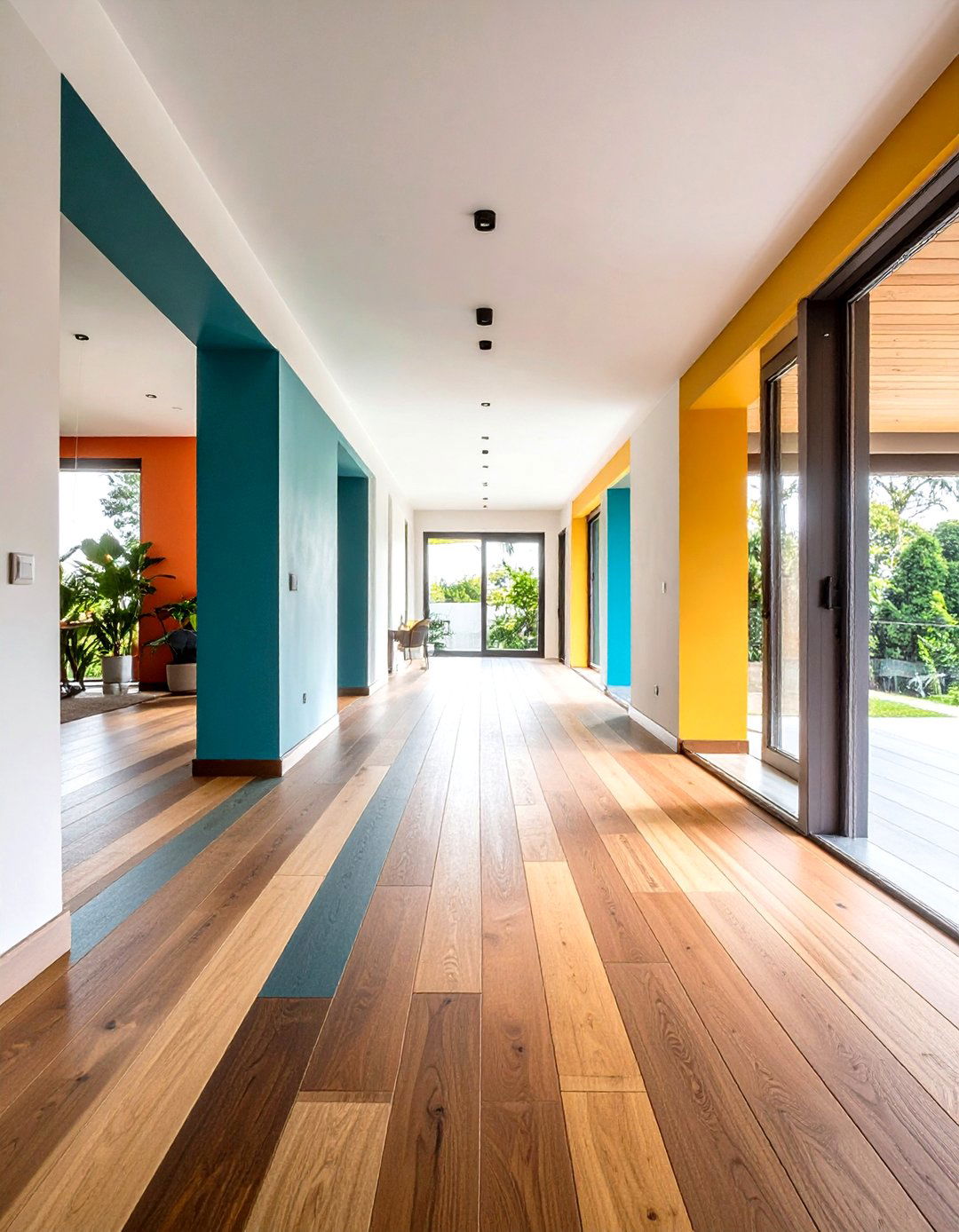
Diagonal wood floor installation creates dynamic visual movement by laying planks at 45-degree angles to the room's walls, making spaces appear larger and more interesting than traditional straight installations. Diagonal patterns make small spaces look bigger. The right wood floor pattern does more than look good—it works hard in the background to shift how a room feels. This installation technique naturally guides the eye outward, creating the illusion of expanded space while adding contemporary flair to any interior. Diagonal installation requires more material due to increased waste from angled cuts, but the dramatic visual impact often justifies the additional cost. This approach works particularly well in small rooms, narrow hallways, and spaces where traditional layouts might feel static or boring.
18. Versailles Wood Floor Pattern
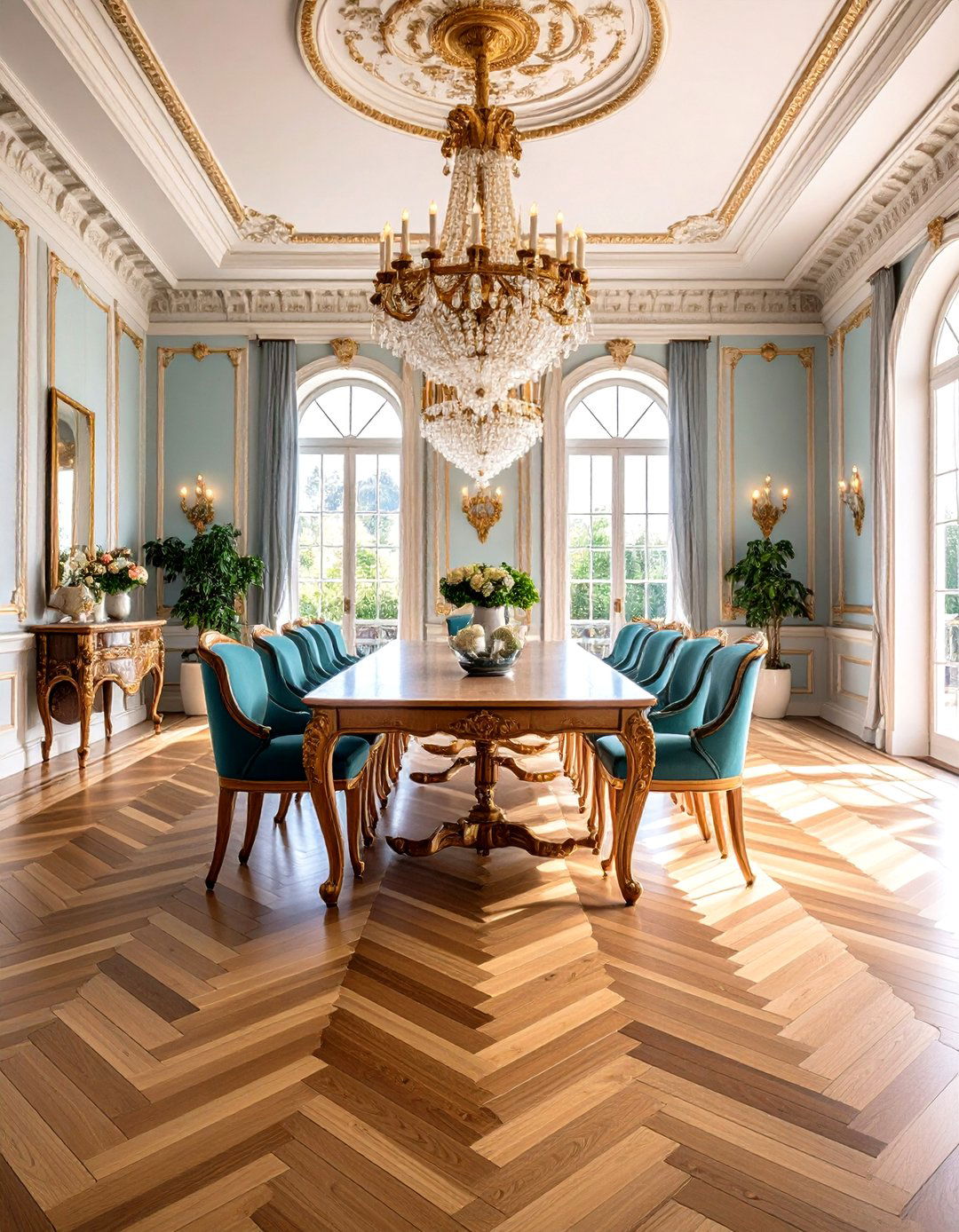
Versailles wood floors feature intricate parquet patterns with woven appearances created through boards cut in various lengths and arranged in complex geometric designs inspired by the famous French palace. Named after the famous Chateau of Versailles palace of King Louis XIV (also known as Louis the Great), this pattern features boards that are cut in a range of long and short lengths. This sophisticated pattern creates formal elegance suitable for grand entryways, formal dining rooms, and spaces where luxury and refinement are paramount. The complex interlocking design requires skilled installation but results in flooring that serves as genuine artwork. Versailles patterns work particularly well with traditional and transitional décor where their European heritage complements classic furnishings and architectural details.
19. Basket Weave Wood Floor Design
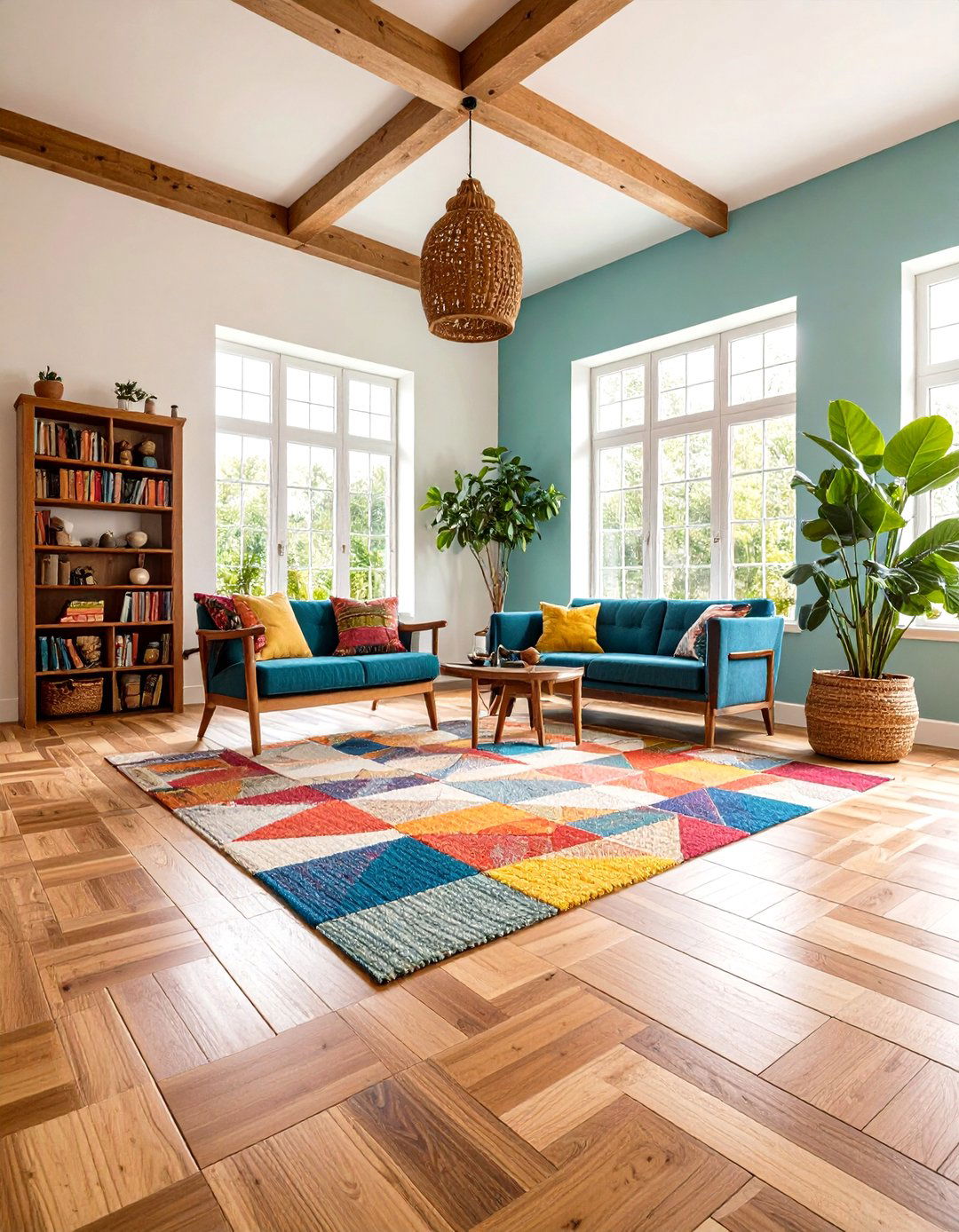
Basket weave wood floors create charming, textile-inspired patterns through small blocks of wood arranged to mimic the over-under appearance of woven baskets, adding warmth and visual interest to any space. Basketweave: Planks are grouped in pairs or triplets to create a woven appearance, similar to a textile pattern. This pattern works exceptionally well in smaller, more intimate spaces where its detailed appearance can be properly appreciated. The repetitive geometric design creates rhythm and movement while maintaining a comfortable, homey feeling that suits traditional and country-style décor. Basket weave patterns can incorporate multiple wood species for added contrast or use single species for subtle texture. The smaller scale of individual elements makes this pattern ideal for powder rooms, studies, and cozy reading nooks.
20. Smoked Wood Floor Finishes
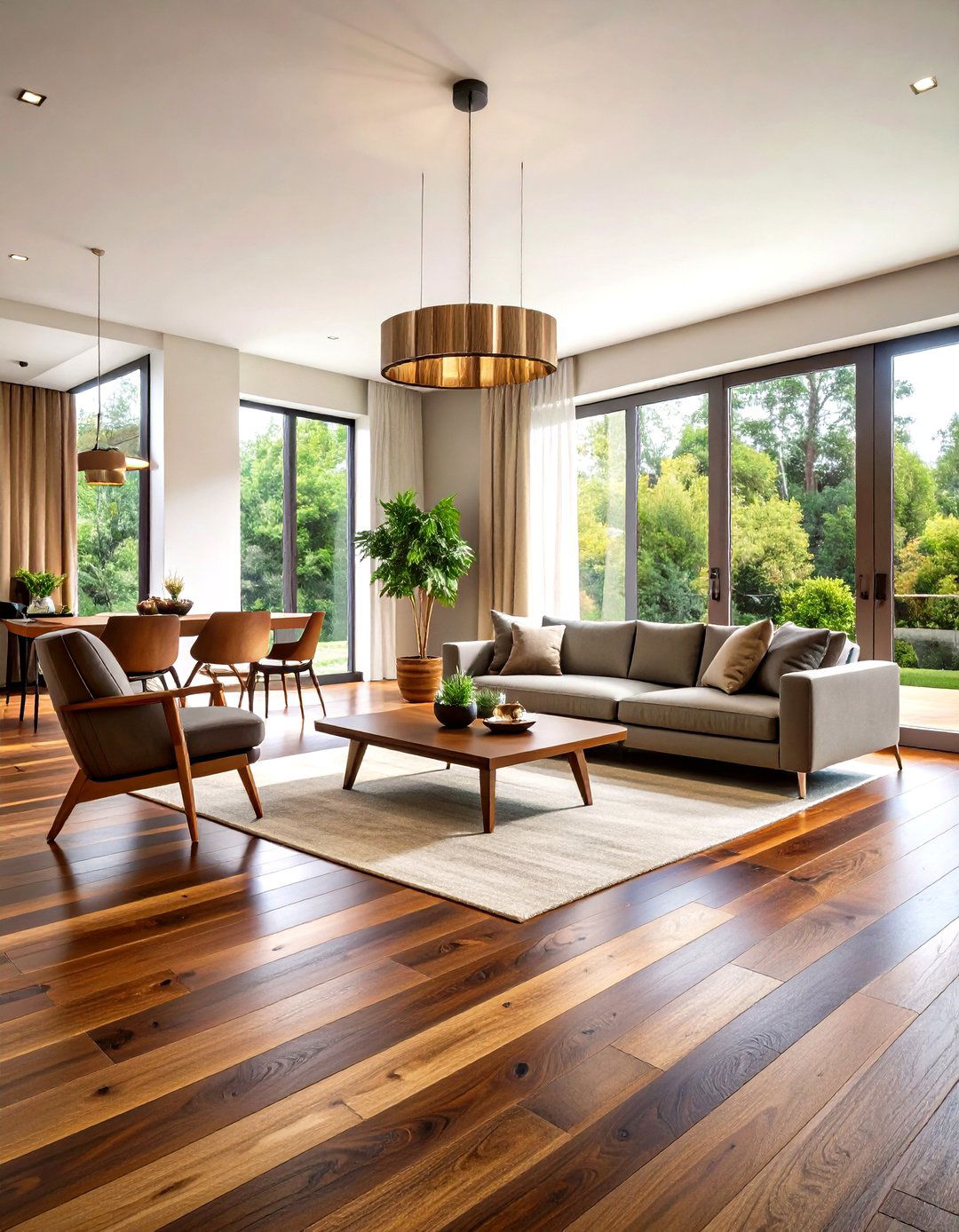
Smoked wood floors achieve rich, deep coloration through exposure to ammonia gas that reacts with the wood's natural tannins, creating warm, organic tones that penetrate throughout the wood rather than sitting on the surface. There's also smoked or fumed wood, which lends a warm, organic look to the wood flooring. Fumed wood is created by placing planks in a chamber and exposing the wood to ammonia gas. This process creates even coloration that won't wear away with sanding and refinishing, making it a long-term investment in distinctive flooring. Smoked finishes work particularly well with oak species, where the reaction creates beautiful chocolate and coffee tones. The natural variation in tannin content creates subtle color differences that add character while maintaining overall harmony throughout the installation.
Conclusion:
These twenty wood floor design ideas showcase the incredible versatility and timeless appeal of hardwood flooring in modern homes. From classic patterns like herringbone and chevron that bring European elegance to contemporary approaches like mixed materials and wide planks that embrace minimalist aesthetics, wood floors continue evolving while maintaining their fundamental warmth and beauty. Whether you choose subtle natural finishes that celebrate wood's inherent character or bold statement designs featuring medallions and borders, the right wood floor design becomes the foundation for memorable, sophisticated interiors that will be treasured for generations.


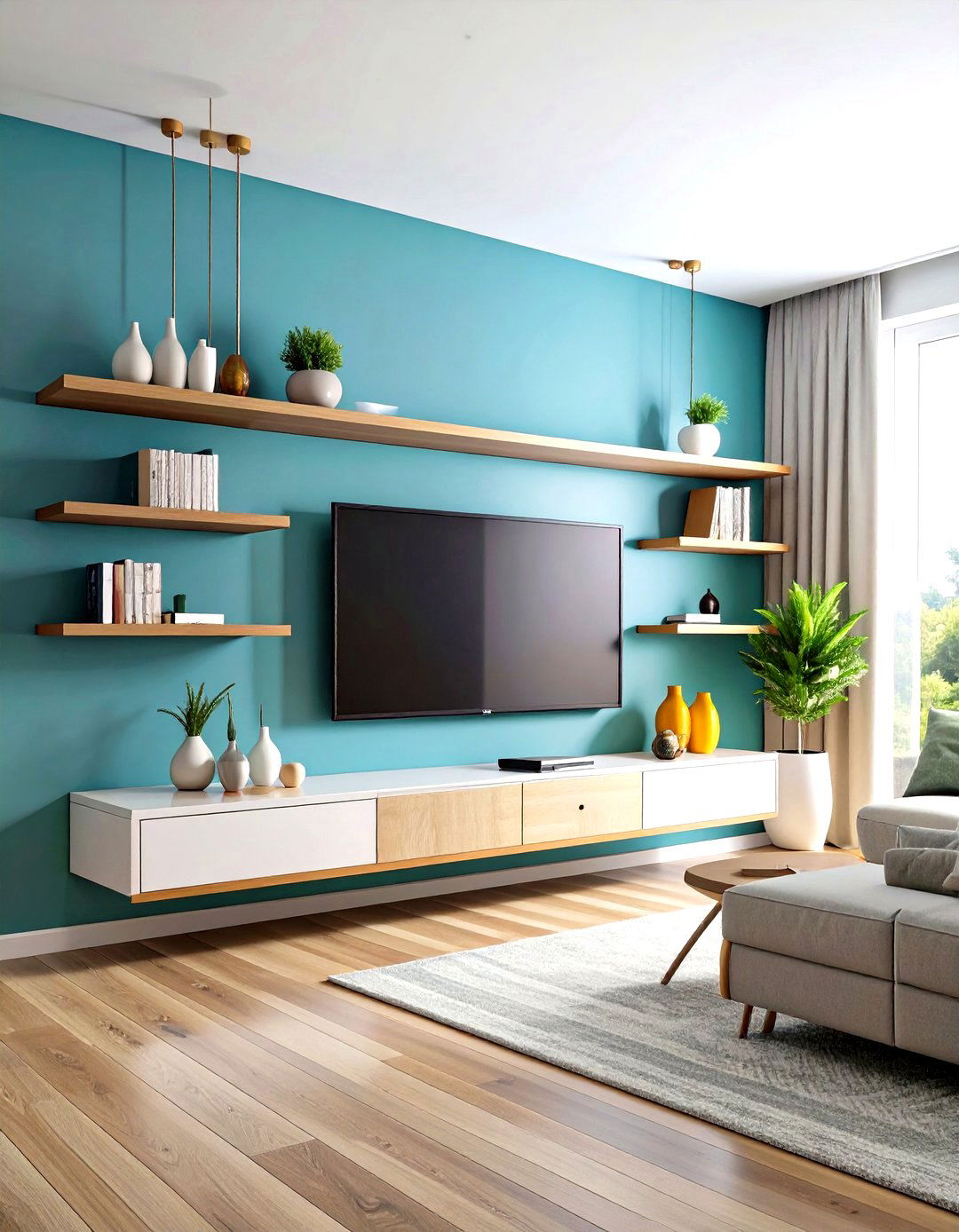
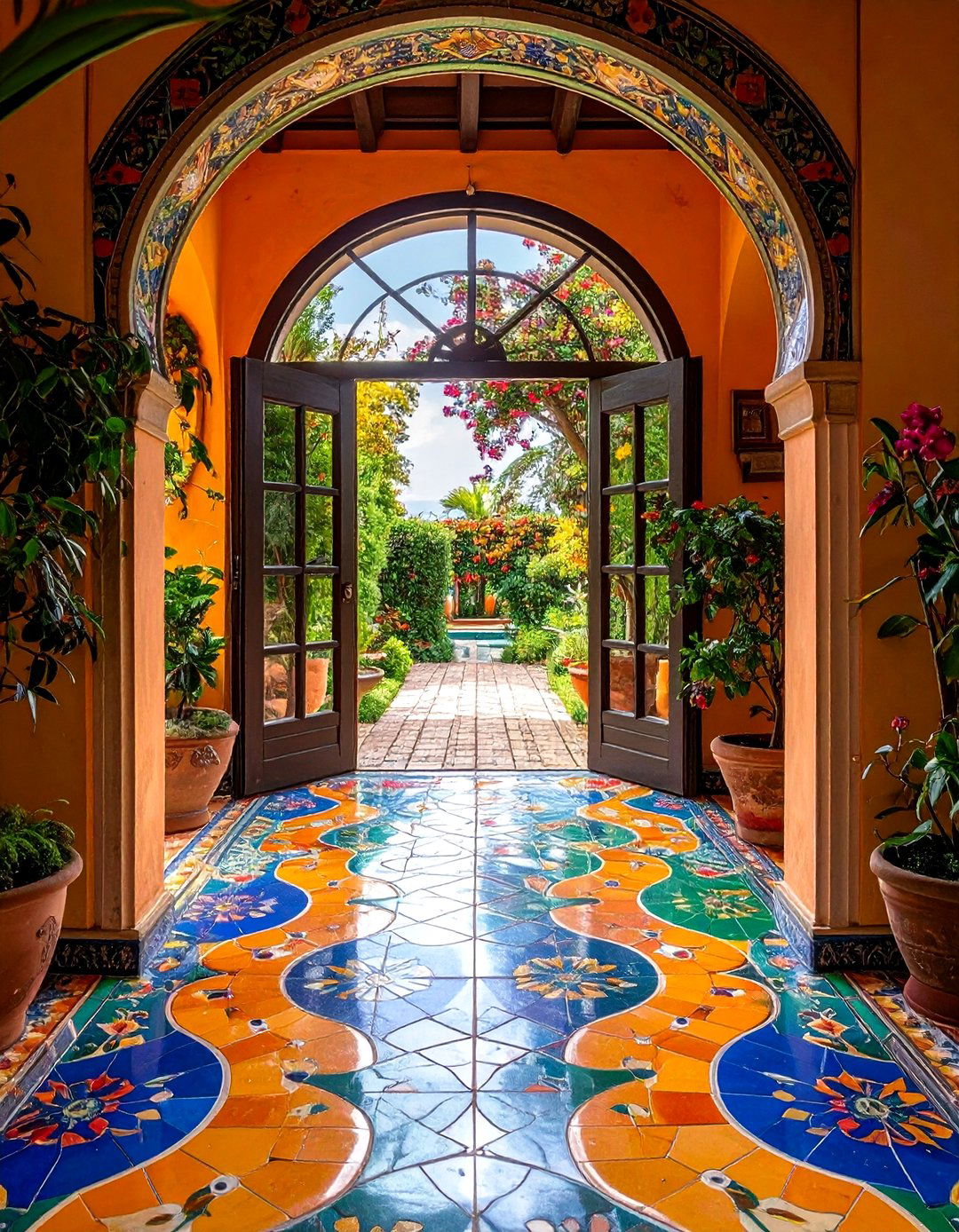
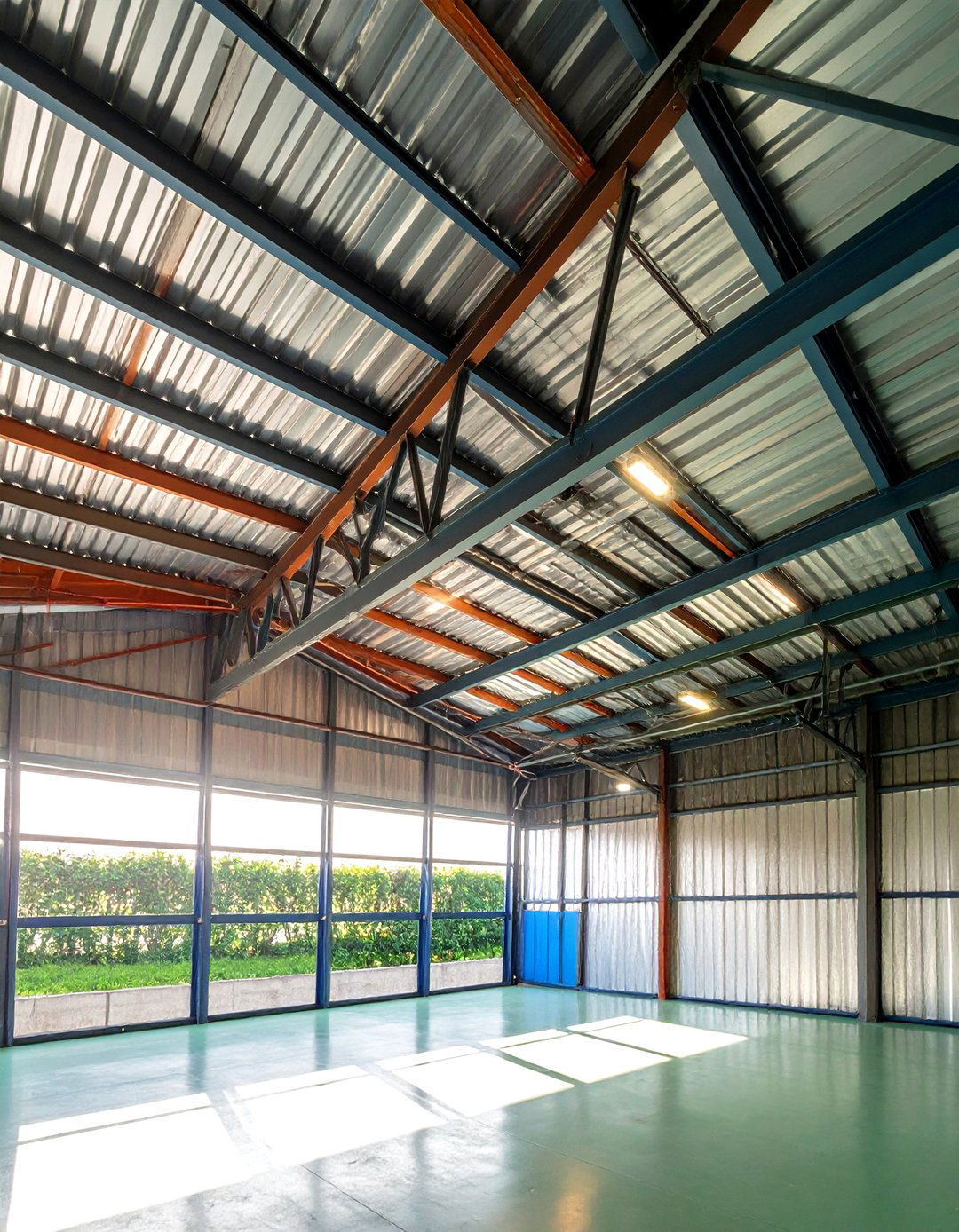


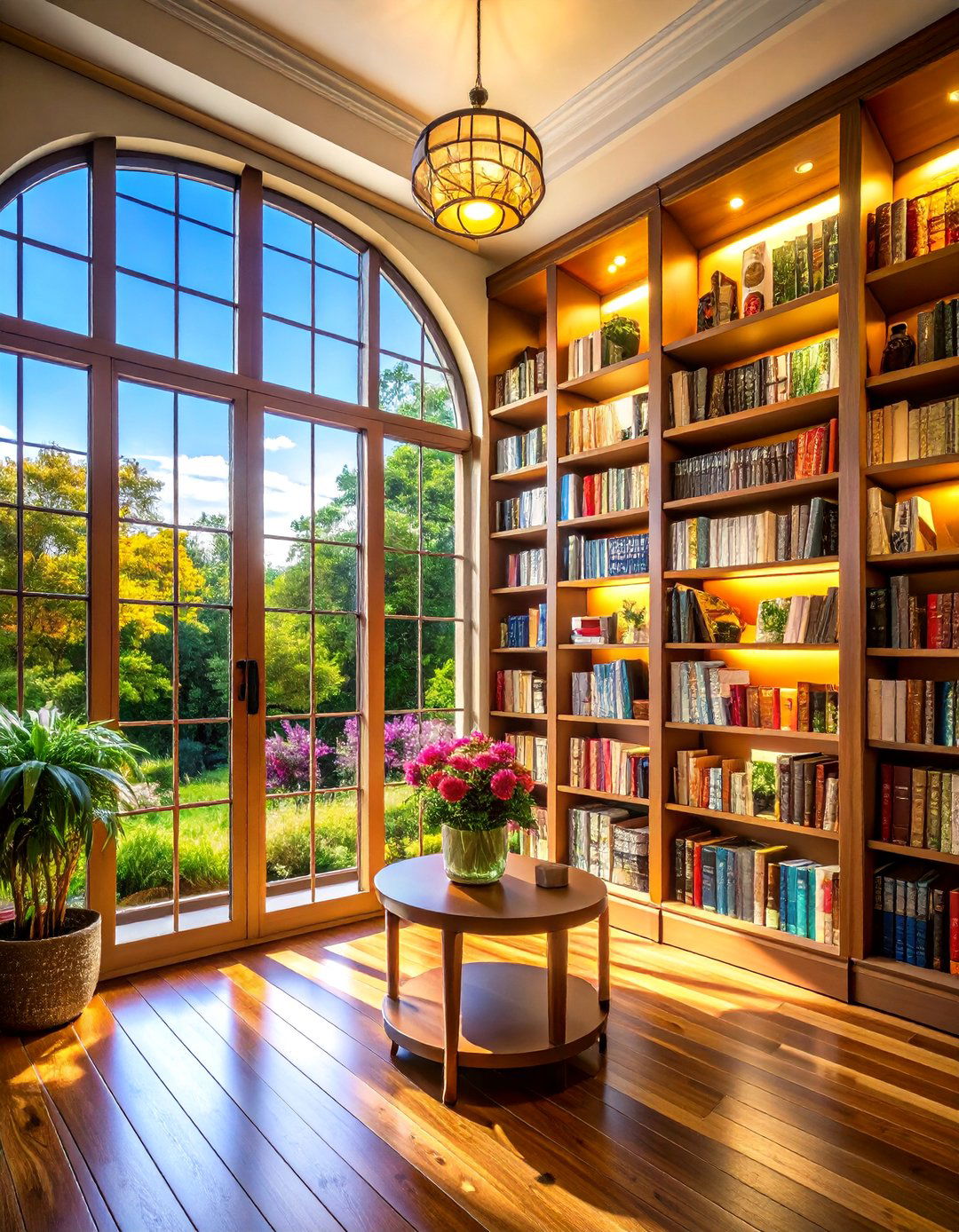
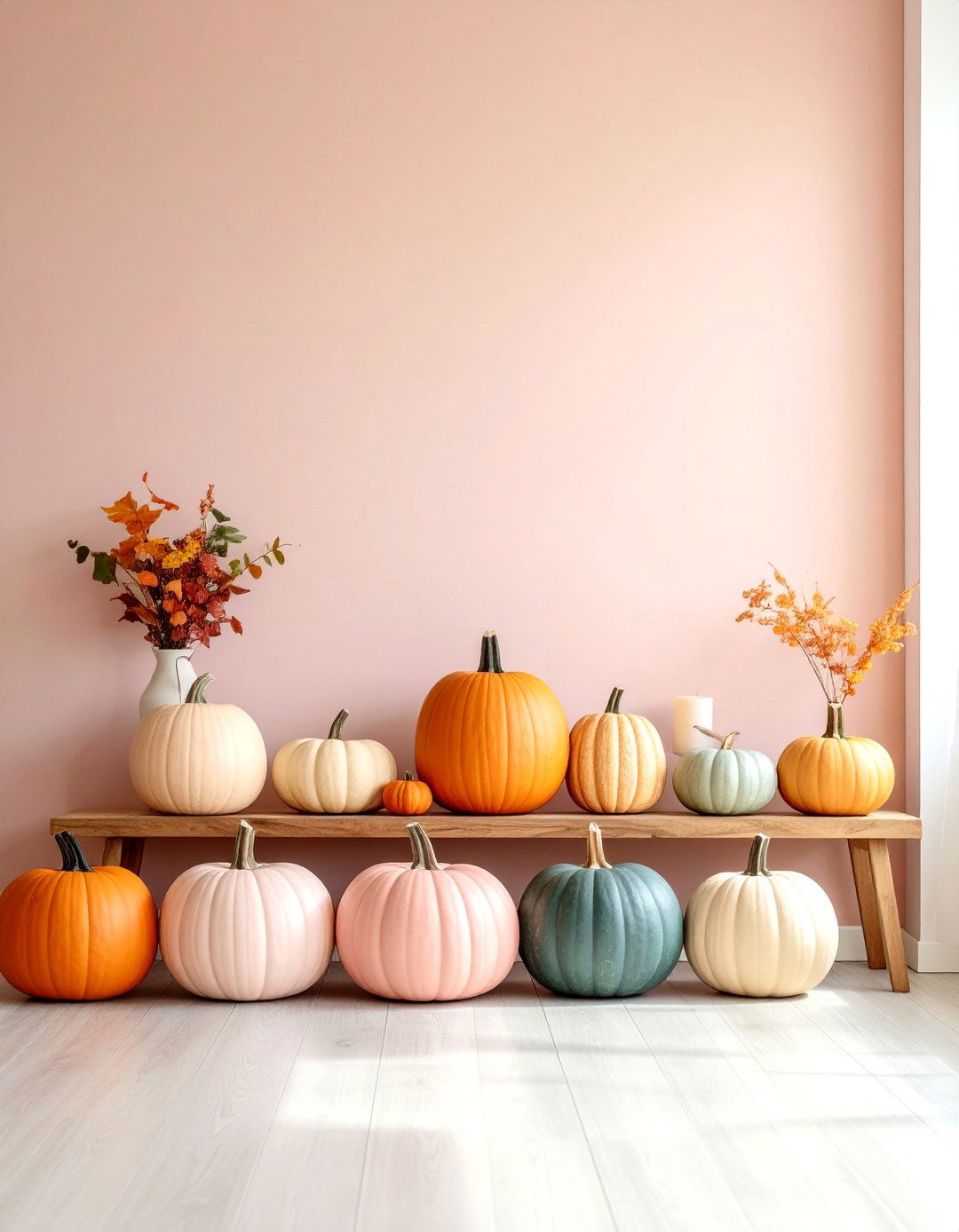
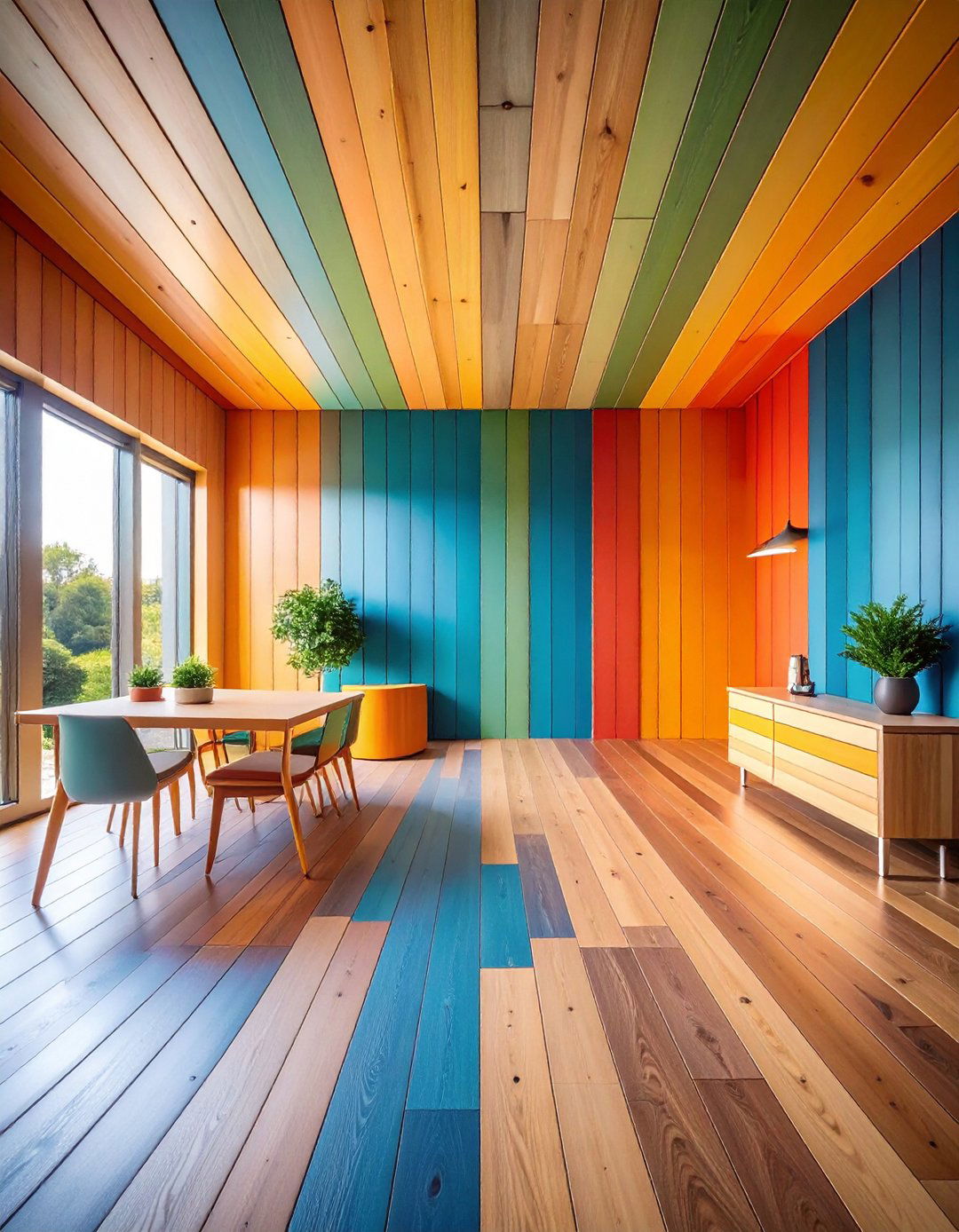
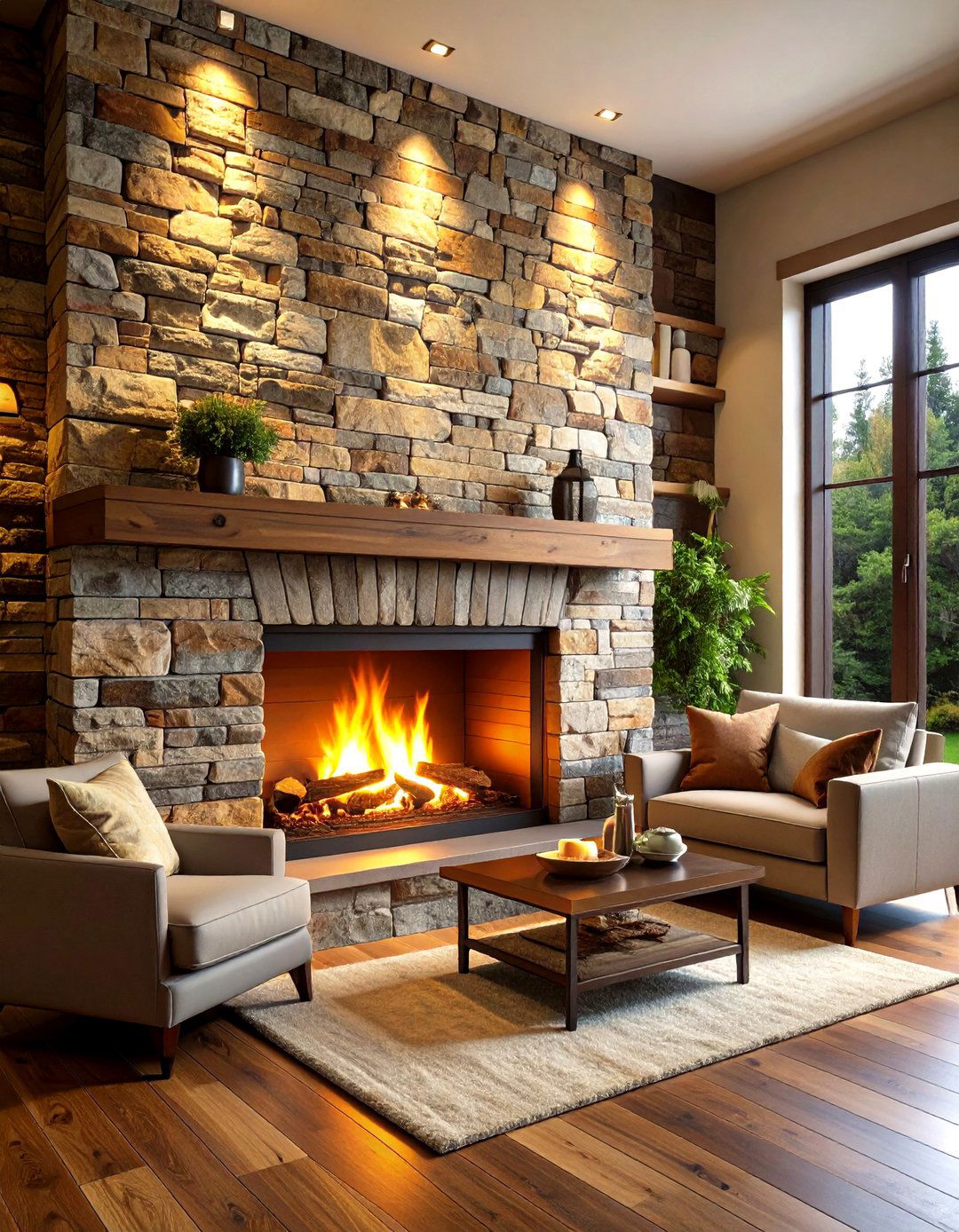
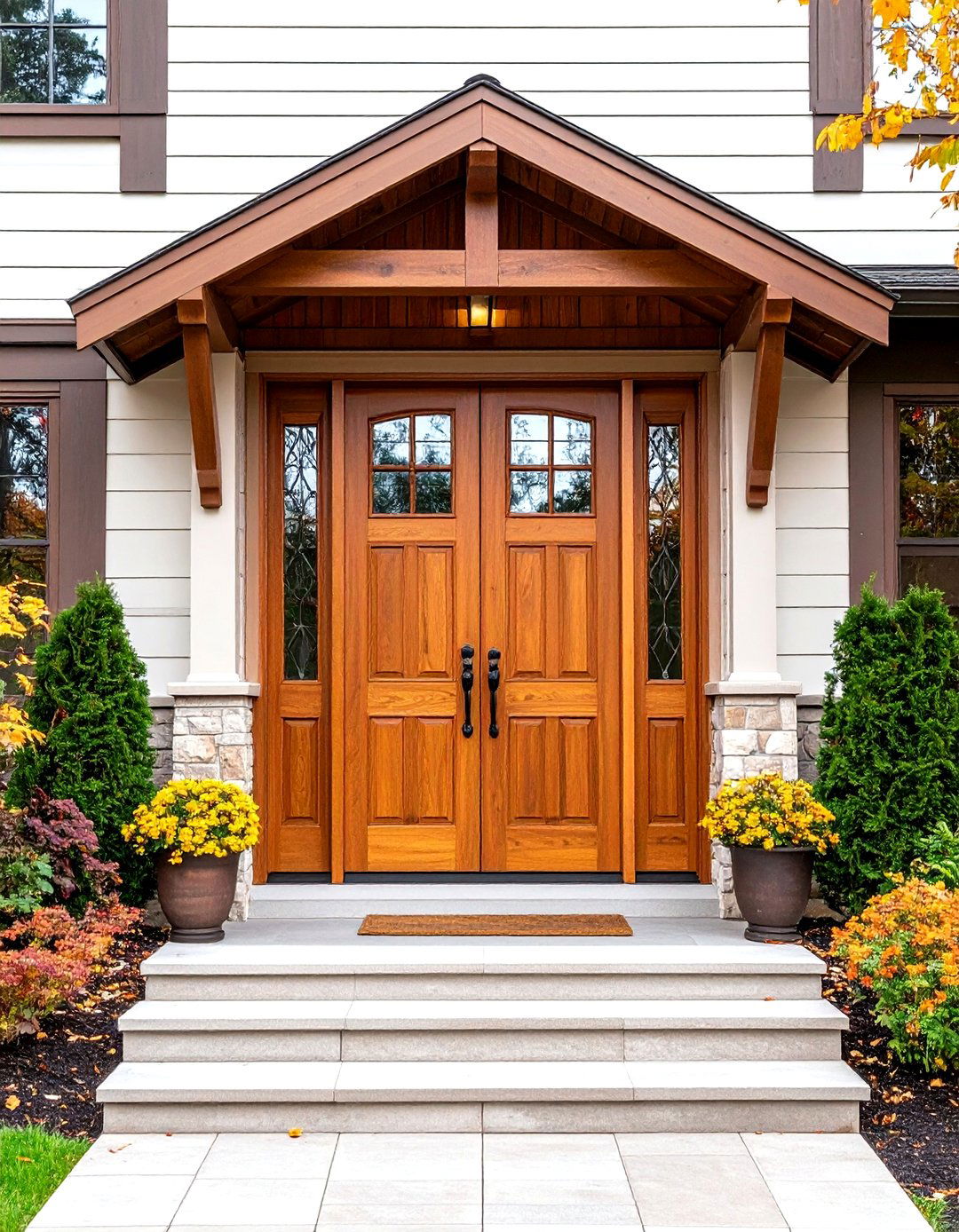
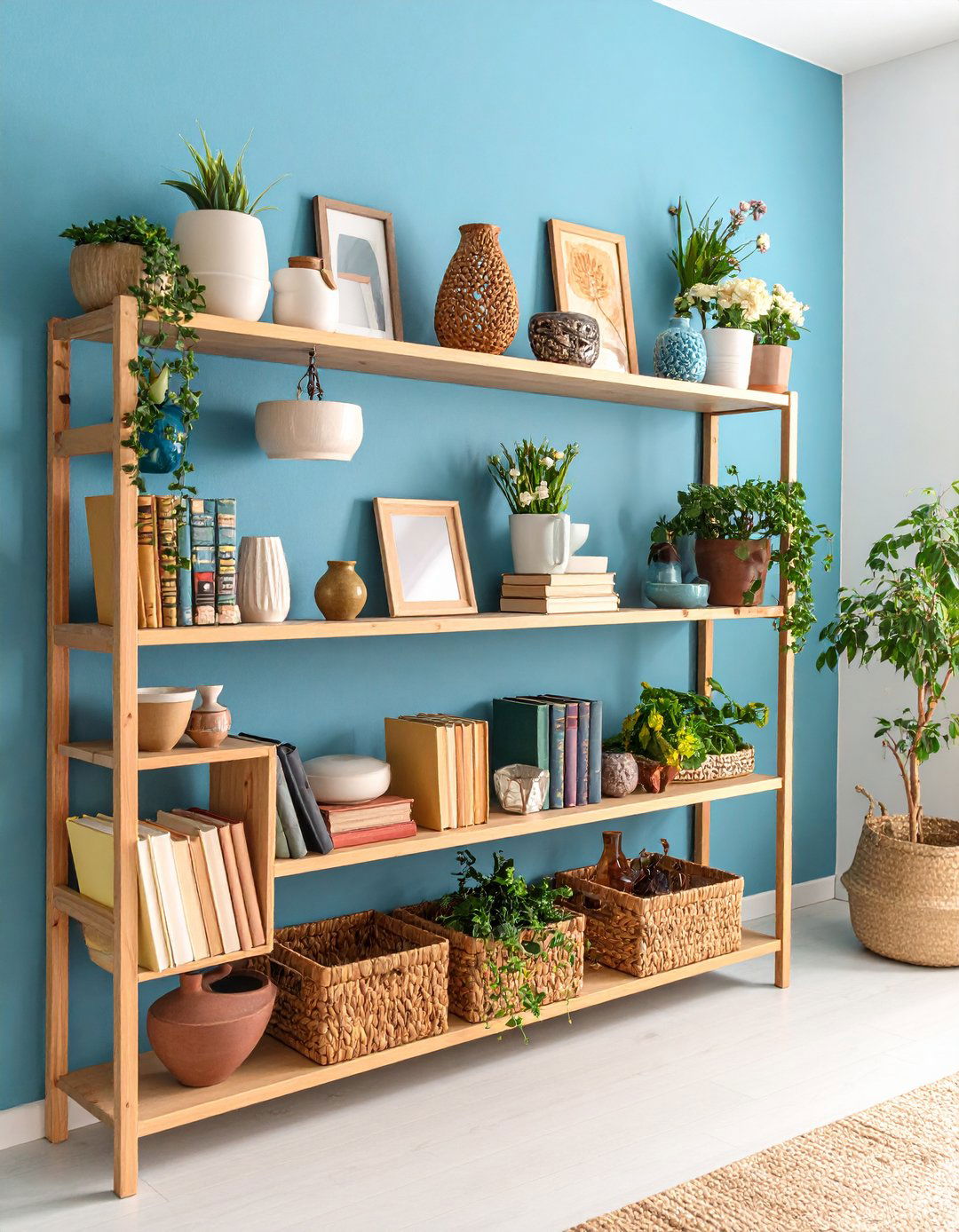
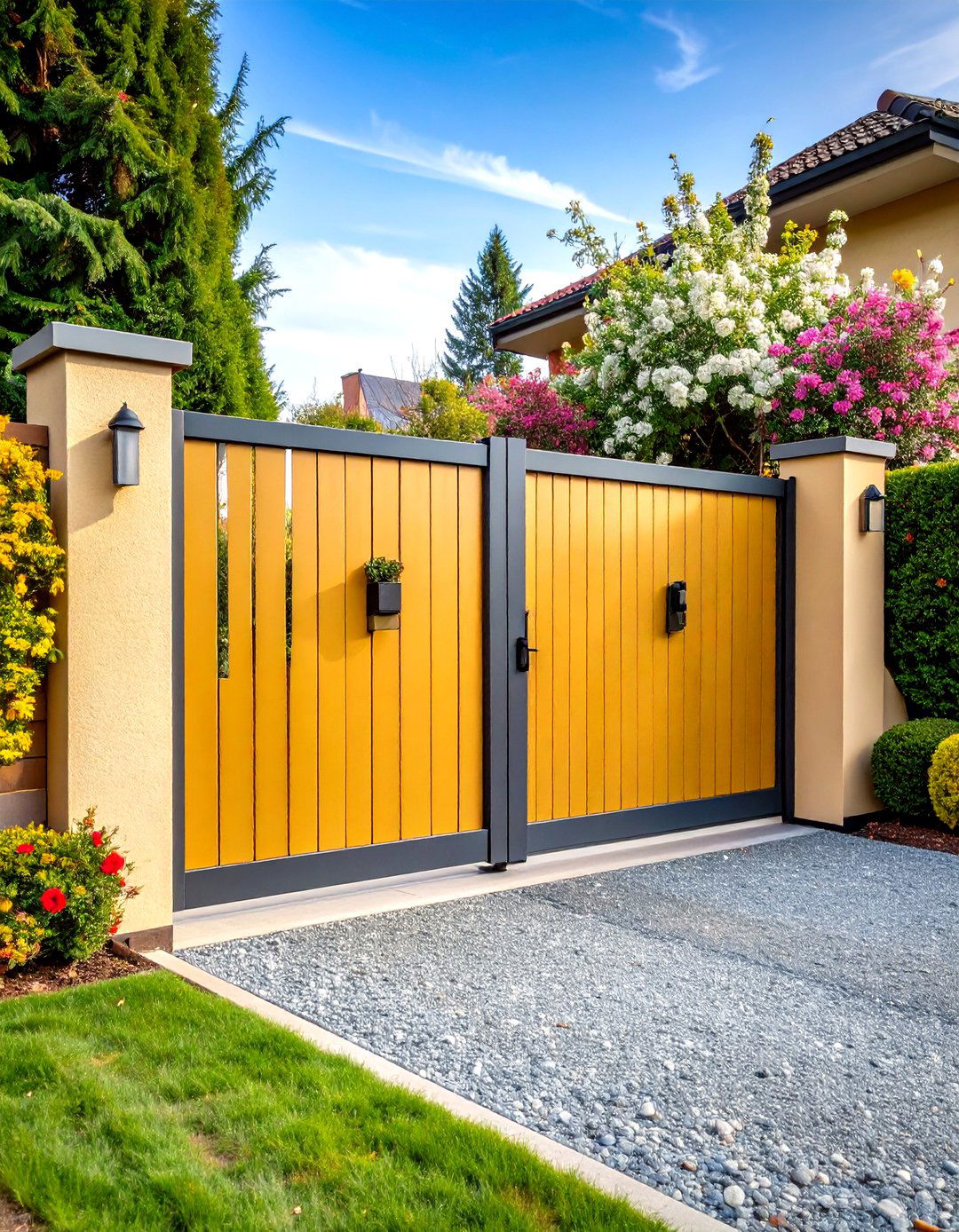
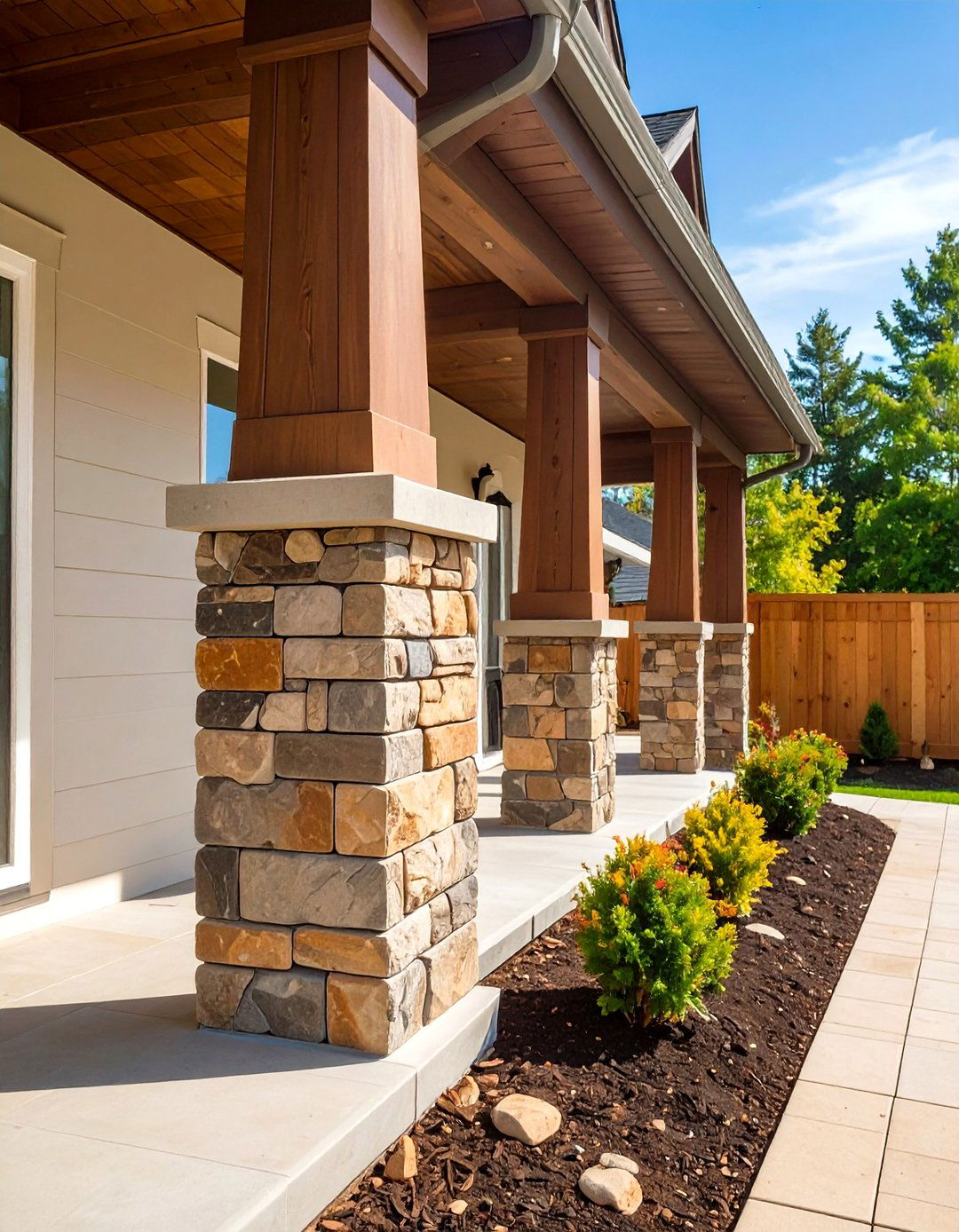
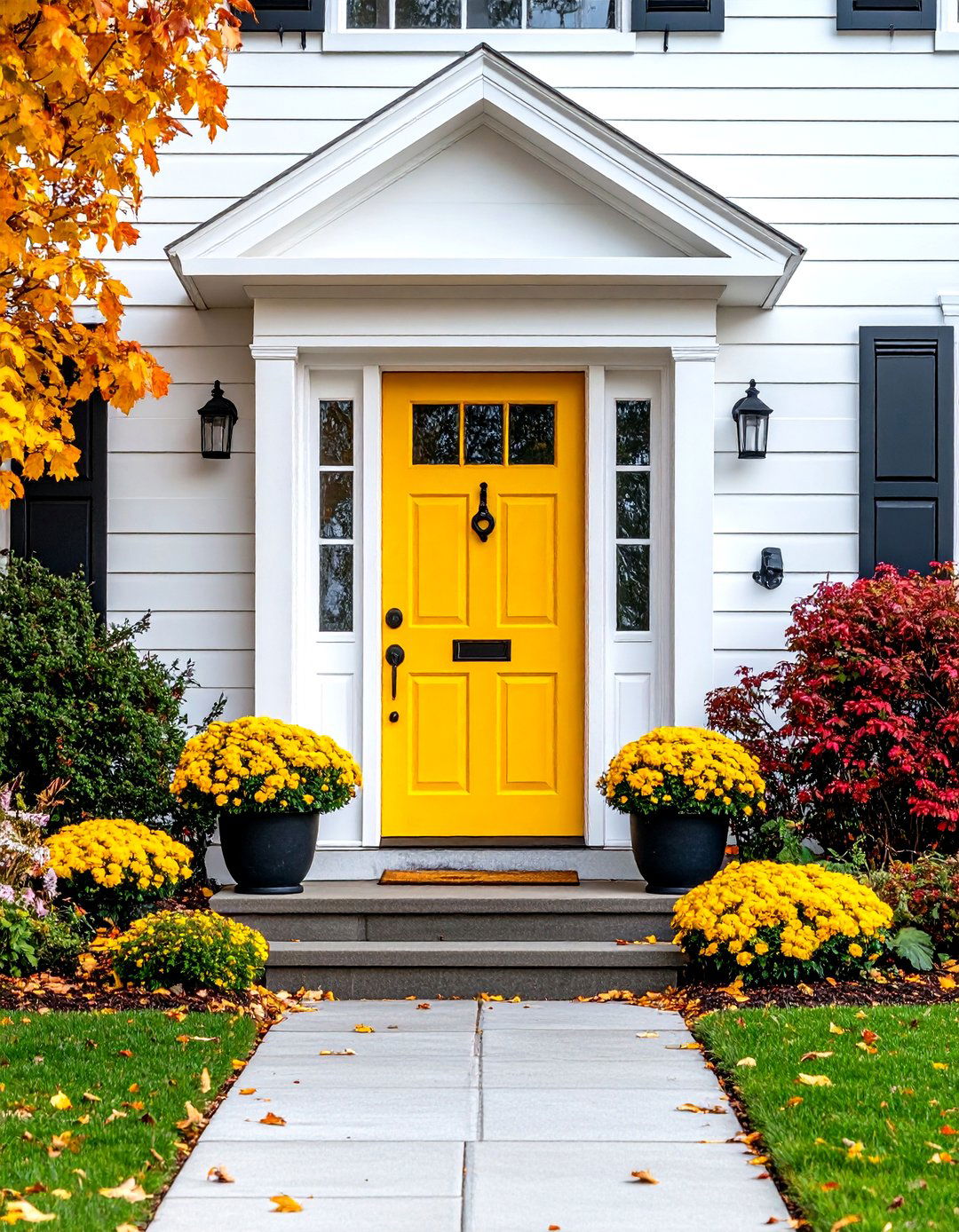
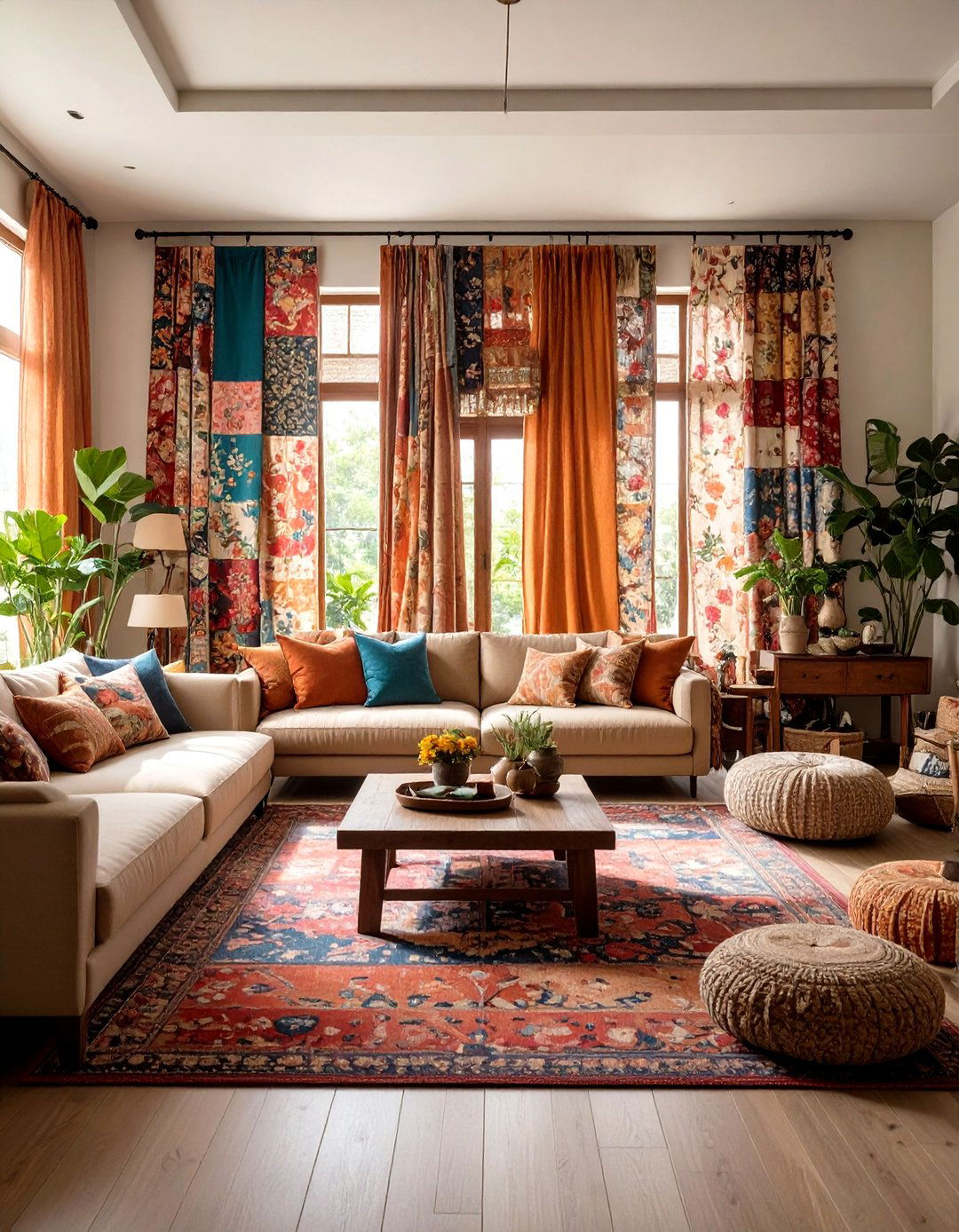
Leave a Reply